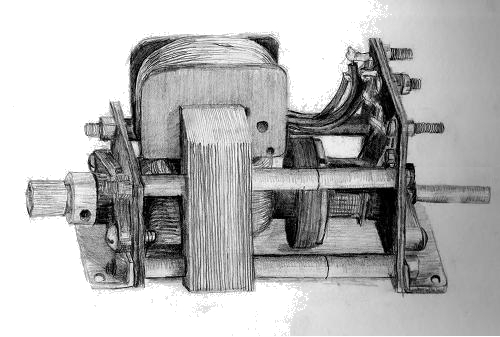Minor Design Variations and Thoughts about Paint......
Taycol Model Marine Electric Motors
Taycol Oddities - a series of musings on various Taycol-related matters or features of the Taycol motors which I don't understand.
The Taycol motor appears to be a straightforward design, and all its working parts are in plain view. For a long time I assumed that the designs, once set, were fixed. But, looking at the few Taycols I have, this does not necessarily seem to be the case.
Taycols are built from very simple raw materials. Brass, steel and paxolin sheet arrived at the factory, was stamped out and assembled. If a raw material supplier can't supply you one day, you need to find another. One of my Taycols has steel angle mounting brackets and nuts rather than brass - I suspect there was a brass shortage at the time. Others have different shades of varnish colour. I have red, blue, green and black paints on the facings of the coil lamination plates, though quite a lot of them are plain metal. Some people have theorised that these indicate different voltage but in some cases I have identical motors with the same coil resistance and same wire gauge (suggesting the same number of turns) that have different colours.
Interestingly, I have several motors which look never to have had any paint on the lamination plates, and one which seems to have the two outer coil laminations made from a different, whiter metal - aluminium, perhaps? But why put aluminium on the outside of a set of coil laminations? Indeed, why paint them at all, on the front and back but not the sides? The reason electro-magnetic equipment is often built of laminations is to suppress eddy currents which detract from the system's efficiency, but that is helped by varnish or paint layers between the laminations, not outside...
The late 40s and early 50s were known in the UK as the 'Austerity Years', since the war had completely disrupted the normal supply paths, and people were encouraged to 'Make Do and Mend". So my suspicion is that this is simply a case of using whatever paint was available. But I also think the Taycol motors did undergo various developments, either to create better designs or to make better use of available materials. I have seen the word 'type' stamped into the face of a Supermarine, and a report in Model Maker which indicates that the Standard was modified as a result of the magazine's tests. So some features may change. In this case the paint differences may simply be 'type' designations - no paint for the base model, red for the Mk2, and so on. Or the paint might have been a production line or factory designator - changed when the factory moved to new premises? I can't see any support for the 'different voltages' theory. Does anyone out there have any better ideas...?


